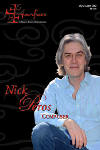Texte paru dans: / Appeared in: |
|
|
Reviewer: Bertil
van Boer There are many smaller subgenres of sacred music that are often little explored. One of these is the sepolcro, a short oratorio-like work that is meant to be performed after the Good Friday services in Roman Catholic regions. The similarity in purpose with the Lutheran cantata is clear, since they often incorporate responses and reflections on the Liturgy, and because of this were particularly favored by the Jesuits as a means of reinforcing the seasonal message. Common enough during the Baroque and early-Classical periods, these works have been largely ignored, probably because they do not easily fit any particular category. They are mostly in Latin (though German and Italian sepolcri do exist), and the poetic texts most often reflect contemplations of horror and disaster. The first of this trio, for instance, talks about a plague that slaughtered 70,000 people, hardly a subject guaranteed to evoke pleasant visions. Zelenka’s three works were composed in a five-year period beginning in 1709 for the Clementinium in Prague, his hometown. Each of these is relatively compact, too small to be labeled an oratorio but perhaps more expansive than your normal cantata. There are usually three or four choruses, often with extensive and quite intricate counterpoint, but the usual recitatives and arias are not always arranged in a conspicuous order. Indeed, in the Immisit Dominus the crux of the work revolves around two accompanied recitatives with soft string suspensions, and in the case of the last, it devolves into a lilting duet between the alto and bass soloists, hardly something that is common during the period. The arias follow each other in sequence and without recitative, so that the music is more continuous than the conventional cantatas of the period. The rich suspensions of the “Recordare, Domine” and the multilevel continuo and oboe punctuations of the aria “Omnes gentes” in the Attendite bring to mind the clockwork rhythms of Purcell, though the vocal line that floats above it is positively Handelian. There are two back-to-back duets in the Deus dux Fortissime, the first of which Zelenka plays off the two soloists in imitation, while in the next, the soprano and alto blend seamlessly with a deliberate marching continuo. The choruses are, as noted, mostly strict counterpoint, and the fugues that the composer uses in “Adoramus te, Christe” of the second work and the final massive “Da robut, fer auxilium” of the last are every bit as complex and intricate as anything written by Johann Sebastian Bach. In the chorus that precedes the latter, however, the militant “Bella premunt hostilia,” the homophonic voices make a bold pronouncement that stops dead in order for a lone cantus firmus to appear as if out of nowhere. The echoes of Carissimi’s oratorios are clearly in the background here, and the effect is rather audacious. The Collegium Marianum is a Czech group that includes a chorus of eight voices, out of which the four soloists emerge. This gives the sound a wonderful clarity, though of course it reveals any slight mistakes. I will say that I do not find any, and whether or not the recording placement was changed, it sounds as if the choir is much larger. All four of the soloists have a good grasp of the stylistic nuances that bring this to life. Bass Tomáš Král, for instance, has that light, almost baritone quality to his voice that seems just right for this sort of music: flexible enough to handle the ornamentation of the “Deus regit nos” in the second work, but also easily blending with his colleagues, such as with the rich alto (or rather countertenor) voice of David Erler in the “Clamate, guttae sanguinis” of the first. The performance by the ensemble seems to be larger than their one-on-a-part actual displacement, and the way this is done, with clear direction by the conductor, allows for it to blend with the singers, no matter if with strings or when the various woodwinds are added. In short, this is a wonderful disc, dramatic and focused, musically adroit, and something that may make my Want List for the year.
| |
|
|
|
|
|
|
|
Cliquez l'un ou l'autre
bouton pour découvrir bien d'autres critiques de CD |
|




